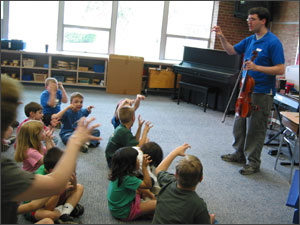Vol. XVIII No. 2 October 2002 |


| A Rochester Residency
A Carnegie Hall debut? Try Council Rock Primary School, where I had the pleasure of teaching and performing for some 460 first- and second-graders as part of a residency project last May. The idea for the residency began several months ago when I was looking for funding to help pay for a recital that I planned to give in my hometown of Rochester, N.Y. A representative from a Rochester-area community foundation explained that his organization's charter did not allow it to make grants directly to individuals. However, he suggested that I try writing a proposal for a project I could do in the public schools. If the proposal was accepted, then the foundation could provide me with funding, which I could use to cover the costs of the recital. I put together a proposal to create the artist-in-residence position in my former school district, outlining what all of my responsibilities would be. Over the course of three weeks, I was to perform four recitals, lead three viola sectional rehearsals, and perform a solo with a student orchestra. On top of this, I was to present several hours of aesthetic education programming to primary-school students and teach numerous group lessons to beginning and other viola students. All in all, the proposal involved more than 25 hours of teaching and performing for roughly 700 students in four different schools. I completed this project over the course of three weeks last May. When I arrived on the first day, I didn't know what to expect. How would the high school students react to me? Just two years ago, I sat alongside many of them in our school orchestra. What right did I have to stand in the front of the room, leading them in a rehearsal? Despite these worries, everything went (more or less) smoothly. The sectional rehearsals were the most challenging for me because I had only 45 minutes to present numerous musical and technical concepts. I quickly learned that the teaching style I am used to at Juilliard simply did not work with many of these students. In some cases, asking a young violist to stand up straighter or to play more in tune literally had no effect. Eventually I realized that merely helping a student to notice his posture or intonation was a significant accomplishment. This was an important lesson about self-awareness that I have begun to incorporate into my own practicing. The recitals that I gave were especially rewarding because the students were such an enthusiastic audience. I chose a 40-minute program of music by Bach, Hindemith, Mozart, and Telemann. I spoke a little about each piece at the beginning of each performance, and I took questions afterward. The questions ranged from the inevitable ("How much do you practice?") to the irrelevant ("Are you married?") to the bizarre ("Do you feel like you're full of fluff when you play the Hindemith?"). But I was struck by how thoughtful the vast majority of their questions were, such as "Why are you a musician?" or "Why did I like the Hindemith even though it's so hard to listen to?" The final component of the residency was three full-time days of teaching aesthetic education to first- and second-graders. The idea behind aesthetic education is that performers can prepare the students to be active listeners by heightening their sensitivity to one salient element of a work. I chose to perform a movement of a solo Bach work and a movement of a solo Hindemith work, designing my lesson plan around the different types of meter in each piece. Whereas the Bach remains in a consistent meter throughout, the Hindemith changes meter erratically, meaning that each measure contains a different number of beats. I taught the students how to count and clap these different types of meters. Over the course of each class, the students learned to perform patterns of increasing complexity. By the end of the lesson, the children were able to count and clap one pattern that represented the meter of the Bach and another pattern that represented the meters used in the Hindemith. To demonstrate this, I asked the kids to clap the patterns while I played along short excerpts from each piece. At this point, the students were ready to listen to each movement in its entirety. To see the smiles on the kids' faces when they heard the connection between their clapping and my playing was truly gratifying. In sum, this residency was by far the most rewarding musical experience I have ever had. It is one thing for young musicians to worry about diminishing audiences for classical music. But it is another thing to actively cultivate future audiences through quality arts education. The residency provided me the extraordinary opportunity to share wonderful music with the most receptive audience I've ever seen. I couldn't imagine a better way to spend those three weeks.
Ed Klorman is a third-year viola student. |
||||
|
||||
